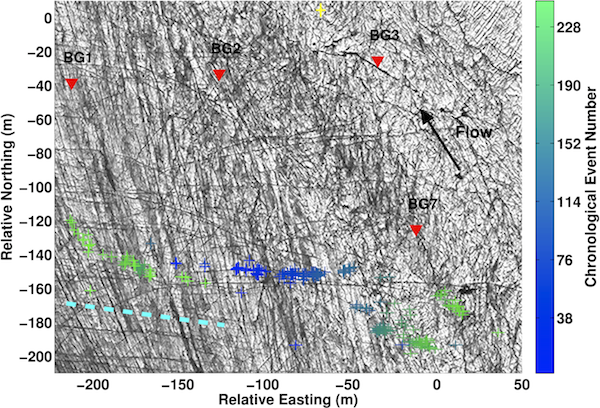2012 IRIS Workshop
Monitoring Glacier Surface Seismicity in Time and Space Using Rayleigh Waves
T. Dylan Mikesell:, Kasper van Wijk: Department of Geosciences, Boise State University
Zoom around the feature in the southwest corner of the seismic array. The 235 type A events start in the middle and propagate to each end of the fracture over 200 minutes. The dashed cyan line indicates the dominant crevasse alignment relative to the valley wall.

Full-resolution graphics file in original format: 0039.ps
We identify seismic sources in glacier ice having a large Rayleigh wave component using a cross-correlation search method. We observe thousands of surface-related icequakes in continuous passive seismic recordings from a nine station array at Bench Glacier, Alaska, USA. Of all the events, we locate 654 events with high signal-to-noise ratios using a Rayleigh wave travel-time inversion. One cluster of epicenter locations is related to a single crevasse. Based on the surrounding crevasse patterns we observe in a satellite image and the known stress relationship between the glacier and the valley walls, we interpret this seismic cluster as an opening crevasse that propagates 253~meters in 200 minutes. We analyze the Rayleigh-wave amplitudes in this cluster to estimate seismic attenuation in the ice, which may serve as a (time-lapse) monitoring tool in future studies. Developing a relationship between the geometrically corrected Rayleigh-wave amplitudes and the seismic moment, we estimate the mean volumetric opening along the crevasse. The small amount of opening leads us to infer that many small events lead to the crevasse opening. Furthermore, a diurnal periodicity indicates a relationship between the overall surface seismicity and the surface temperature. We hypothesize that surface seismicity is largely controlled by surface melt and subglacial water pressure changes. Finally, we show that a waveform cross-correlation method is an efficient way to identify shallow seismicity in this glacier system. This implies that in other glacier and ice-sheet systems, this method can be used to identify seismicity associated with a specific failure mechanism.
Acknoweldgements: The Bench Glacier project is supported by the National Science Foundation (NSF), Grant #ARC-0454717. The instruments were provided by the Incorporated Research Institutions for Seismology (IRIS) through the PASSCAL Instrument Center. Data collected during this experiment are available from the IRIS Data Management Center. The facilities of the IRIS Consortium are supported by the NSF under Cooperative Agreement EAR-0552316 and by the Department of Energy National Nuclear Security Administration.
For further reading: Visit our publications website for complete list: http://earth.boisestate.edu/pal/peer-reviewed-publications/ doi: 10.1029/2011JF002259
Keywords: glacier, rayleigh_waves, crevasse_growth
